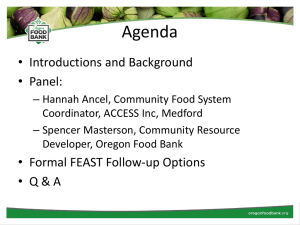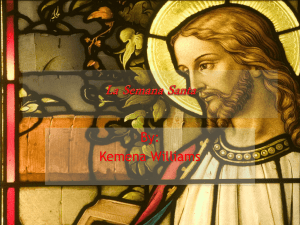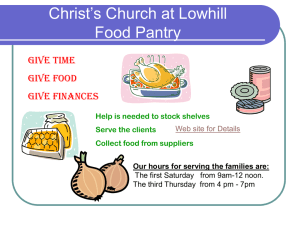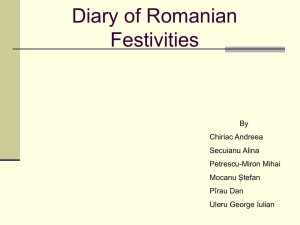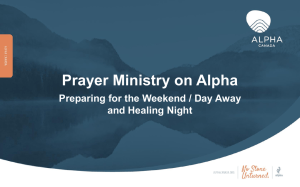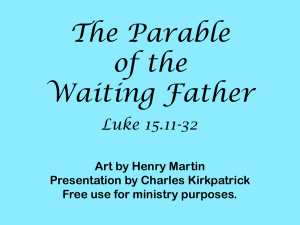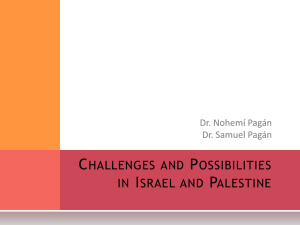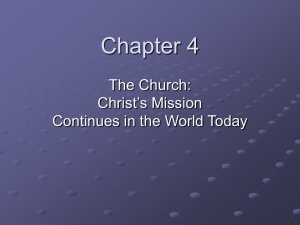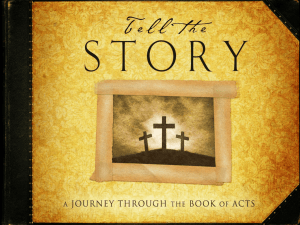Feast Days - St. John the Evangelist
advertisement
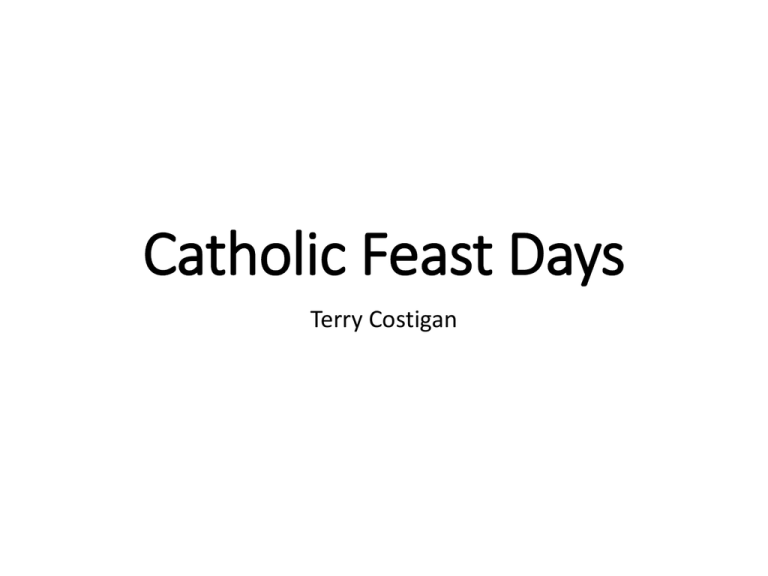
Catholic Feast Days Terry Costigan What is a Feast Day? • Feast Days, or Holy Days, are days which are celebrated annually in commemoration of the sacred mysteries and events recorded in the history of the Church. • An opportunity for the laity to hear specific Church teachings not normally heard during the year • Examples of modern Feast Days: ‒ Events in the life, death, and resurrection of Christ (12) ‒ Mary the Mother of Christ (10) ‒ The Apostles, Martyrs, and Saints (hundreds) • The purpose of all Feast Days is to move us closer to Christ (the process of sanctification) So Why So Many Feast Days? • Example of a Saint’s Feast Day: St. Polycarp (Feast Day: Feb 23) • 8000-10000 saints recognized by Church • Initially, local churches had so many feast days they had a significant negative impact on the economy. — Some countries / dioceses had over 60 feast days / year — Typically all feast days were celebrated by the Church (Mass attendance was obligatory) — In the past, required abstention from work • Today there are multiple Saints’ feast days celebrated nearly every day of year • Celebration of Feast Days takes the form of a Mass with the Eucharist ‒ Some feast days are also celebrated with parties • Do we pray to the Saints? No – we ask the Saint, who are more holy and closer to God than us, to pray for us. Feast Day Ranking There is a ranking of importance of feast days ‒ Solemnity: highest ranking for celebrations with our Lord’s life on earth, Mary, and certain saints ‒ Feast: next rank down for certain saints and the Apostles ‒ Memorial: for most of the saints General List of Solemnity Feast Days Note that some feast days are on the same date every year (Christmas, Mary Mother of God, specific saint’s day, etc…) Others move around relative to Easter (Ascension, Pentecost, etc…) Holy Days of Obligation List of Some Country Specific Solemnity Feast Days Feast Days Specific to the USA Some Feast Days for January Feast Days Celebrated on January 1st Note that nearly every day of the year numerous Saint’s Feast Days are celebrated, although most are the lowest classification (Memorial) and would not necessarily be mentioned in daily mass. Holy Days of Obligation • With so many feasts, how do we know which are the most important? • The Church helps us by declaring Holy days of obligation – ‒ ‒ ‒ Considered the minimum level of commitment to our Faith Often different country to country Missing Mass considered a mortal sin 6 days in USA: o Solemnity of Mary Mother of God Jan 1 o Ascension 40 days after Easter o Assumption of the Blessed Virgin Aug 15 o All Saints Nov 1 o Immaculate Conception of the Blessed Virgin Mary Dec 8 o Christmas Dec 25 Solemnity of Mary, Mother of God Ascension of Our Lord History of the Ascension of Our Lord The reality of Christ's Ascension is so important that the creeds (the basic statements of belief) of Christianity all affirm, in the words of the Apostles' Creed, that "He ascended into heaven, sits at the right hand of God the Father almighty; from thence He shall come to judge the living and the dead." The denial of the Ascension is as grave a departure from Christian teaching as is denial of Christ's Resurrection. Christ's bodily Ascension foreshadows our own entrance into Heaven not simply as souls, after our death, but as glorified bodies, after the resurrection of the dead at the Final Judgment. In redeeming mankind, Christ not only offered salvation to our souls but began the restoration of the material world itself to the glory that God intended before Adam's fall. The Feast of the Ascension marks the beginning of the first novena, or nine days of prayer. Before His Ascension, Christ promised to send the Holy Spirit to His apostles. Their prayer for the coming of the Holy Spirit, which began on Ascension Thursday, ended with the descent of the Holy Spirit on Pentecost Sunday, ten days later. Assumption of Mary All Saints Immaculate Conception of the Blessed Virgin Christmas BACKUP SLIDES A celebration of Mary's motherhood of Jesus Ash Wednesday Palm Sunday History of Palm Sunday: Beginning in the fourth century in Jerusalem, Palm Sunday was marked by a procession of the faithful carrying palm branches, representing the Jews who celebrated Christ's entrance into Jerusalem. In the early centuries, the procession began on the Mount of the Ascension and proceeded to the Church of the Holy Cross. As the practice spread throughout the Christian world by the ninth century, the procession would begin in each church with the blessing of palms, proceed outside the church, and then return to the church for the reading of the Passion according to the Gospel of Matthew. The faithful would continue to hold the palms during the reading of the Passion. In this way, they would recall that many of the same people who greeted Christ with shouts of joy on Palm Sunday would call for His Death on Good Friday-a powerful reminder of our own weakness and the sinfulness that causes us to reject Christ. In different parts of the Christian world, particularly where palms were historically hard to obtain, branches of other bushes and trees were used, including olive, box elder, spruce, and various willows. Perhaps best known is the Slavic custom of using pussy willows, which are among the earliest of plants to bud out in the spring. The faithful have traditionally decorated their houses with the palms from Palm Sunday, and, in many countries, a custom developed of weaving the palms into crosses that were placed on home altars or other places of prayer. Since the palms have been blessed, they should not simply be discarded; rather, the faithful return them to their local parish in the weeks before Lent, to be burned and used as the ashes for Ash Wednesday. Holy Thursday History: Holy Thursday is more than just the lead-in to Good Friday; it is, in fact, the oldest of the celebrations of Holy Week. And with good reason: Holy Thursday is the day on which Catholics commemorate the institution of three pillars of the Catholic Faith: the Sacrament of Holy Communion, the priesthood, and the Mass. During the Last Supper, Christ blessed the bread and wine with the very words that Catholic and Orthodox priests use today to consecrate the Body and Blood of Christ during the Mass and the Divine Liturgy. In telling His disciples to "Do this in remembrance of Me," He instituted the Mass and made them the first priests. Near the end of the Last Supper, after Judas had departed, Christ said to His disciples, "A new commandment I give unto you: That you love one another, as I have loved you, that you also love one another." The Latin word for "commandment," mandatum became the source for another name for Holy Thursday: Maundy Thursday. On Holy Thursday, the priests of each diocese gather with their bishop to consecrate holy oils, which are used throughout the year for the sacraments of Baptism, Confirmation, Holy Orders, and the Anointing of the Sick. This ancient practice, which goes back to the fifth century, is known as the Chrism Mass ("chrism" is a mixture of oil and balsam used for the holy oils) and stresses the role of the bishop as a successor to the apostles. Good Friday History: From the earliest days of Christianity, no Mass has been celebrated on Good Friday; instead, the Church celebrates a special liturgy in which the account of the Passion according to the Gospel of John is read, a series of intercessory prayers (prayers for special intentions) are offered, and the faithful venerate the Cross by coming forward and kissing it. The Good Friday liturgy concludes with the distribution of Holy Communion. Since there was no Mass, Hosts that were reserved from the Mass of the Lord's Supper on Holy Thursday are distributed instead. The service is particularly solemn; the organ is not played, and all vestments are red or (in the Traditional Latin Mass) black. Since the date of Good Friday is dependent on the date of Easter, it changes from year to year. (See When Is Easter? for more details.) Fasting and Abstinence: Good Friday is a day of strict fasting and abstinence. Catholics over the age of 18 and under the age of 60 are required to fast, which means that they can eat only one complete meal and two smaller ones during the day, with no food in between. Catholics who are over the age of 14 are required to refrain from eating any meat, or any food made with meat, on Good Friday. Holy Saturday The History of Holy Saturday Also known as the Easter Vigil (a name more properly applied to the Mass on Holy Saturday night), Holy Saturday has had a long and varied history. As the Catholic Encyclopedia notes, "in the early Church this was the only Saturday on which fasting was permitted." Fasting is a sign of penance, but on Good Friday, Christ paid with His own Blood the debt of our sins. Thus, for many centuries, Christians regarded both Saturday and Sunday, the day of Christ's Resurrection, as days on which fasting was forbidden. (That practice is still reflected in the Lenten disciplines of the Eastern Catholic and Eastern Orthodox Churches, which lighten their fasts slightly on Saturdays and Sundays.) By the second century, Christians had begun to observe a total fast (no food of any kind) for 40 hours before Easter, which meant that the entire day of Holy Saturday was a day of fasting. No Mass for Holy Saturday As on Good Friday, there is no Mass offered for Holy Saturday. The Easter Vigil Mass, which takes place after sundown on Holy Saturday, properly belongs to Easter Sunday, since liturgically, each day begins at sundown on the previous day. (That is why Saturday vigil Masses can fulfill our Sunday Duty.) Unlike on Good Friday, when Holy Communion is distributed at the afternoon liturgy commemorating Christ's Passion, on Holy Saturday the Eucharist is only given to the faithful as viaticum—that is, only to those in danger of death, to prepare their souls. In the early Church, Christians gathered on the afternoon of Holy Saturday to pray and to confer the Sacrament of Baptism on catechumens—converts to Christianity who had spent Lent preparing to be received into the Church. (As the Catholic Encyclopedia notes, in the early Church, "Holy Saturday and the vigil of Pentecost were the only days on which baptism was administered.") This vigil lasted through the night until dawn on Easter Sunday, when the Alleluia was sung for the first time since the beginning of Lent, and the faithful— Easter Sunday Easter is the greatest feast in the Christian calendar. On this Sunday, Christians celebrate the resurrection of Jesus Christ from the dead. For Catholics, Easter Sunday comes at the end of 40 days of prayer, fasting, and almsgiving known as Lent. Through spiritual struggle and self-denial, we have prepared ourselves to die spiritually with Christ on Good Friday, the day of His Crucifixion, so that we can rise again with Him in new life on Easter. The Fulfillment of Our Faith Easter is a day of celebration because it represents the fulfillment of our faith as Christians. St. Paul wrote that, unless Christ rose from the dead, our faith is in vain (1 Corinthians 15:17). Through his death, Christ saved mankind from bondage to sin, and He destroyed the hold that death has on all of us; but it is His Resurrection that gives us the promise of new life, both in this world and the next. The Coming of the Kingdom That new life began on Easter Sunday. In the Our Father, we pray that "Thy Kingdom come, on earth as it is in Heaven." And Christ told His disciples that some of them would not die until they saw the Kingdom of God "coming in power" (Mark 9:1). The early Christian Fathers saw Easter as the fulfillment of that promise. With the resurrection of Christ, God's Kingdom is established on earth, in the form of the Church. New Life in Christ That is why people who are converting to Catholicism traditionally are baptized at the Easter Vigil service, which takes place on Holy Saturday (the day before Easter), starting sometime after sunset. They have usually undergone a long process of study and preparation known as the Rite of Christian Initiation for Adults (RCIA). Their baptism parallels Christ's own Death and Resurrection, as they die to sin and rise to new life in the Kingdom of God. Divine Mercy Sunday Divine Mercy Sunday, celebrated on the Octave of Easter (the Sunday after Easter Sunday), is a relatively new addition to the Roman Catholic liturgical calendar. Celebrating the Divine Mercy of Jesus Christ, as revealed by Christ Himself to St. Maria Faustina Kowalska, this feast was extended to the entire Catholic Church by Pope John Paul II on April 30, 2000, the day that he canonized Saint Faustina. History: A plenary indulgence (the forgiveness of all temporal punishment resulting from sins that have already been confessed) is granted on the Feast of Divine Mercy if to all the faithful who go to Confession, receive Holy Communion, pray for the intentions of the Holy Father, and "in any church or chapel, in a spirit that is completely detached from the affection for a sin, even a venial sin, take part in the prayers and devotions held in honour of Divine Mercy, or who, in the presence of the Blessed Sacrament exposed or reserved in the tabernacle, recite the Our Father and the Creed, adding a devout prayer to the merciful Lord Jesus (e.g. 'Merciful Jesus, I trust in you!')." A partial indulgence (the remission of some temporal punishment from sin) is granted to the faithful "who, at least with a contrite heart, pray to the merciful Lord Jesus a legitimately approved invocation." Pentecost Sunday Trinity Sunday Corpus Christi First Sunday of Advent What Is a Catholic Feast Day? The Catholic Church assigns one date out of the year for each and every canonized saint — known as the saint’s feast day. The saints are remembered on their individual feast days with special mention, prayers, and possibly a scripture reading. A saint’s feast day can be the day of their actual death or a day assigned by the Church. Typically, the Church only assigns a day when the day of death is unknown or if several other saints are already assigned to that day. The number of canonized saints, however, is greater than the number of days in a calendar year. So two or more saints often share the same feast day. Because overlap often occurs, and the Church isn’t sure of the date of death of some saints, other calendar dates are sometimes chosen — such as the day that the saint was canonized. Some saints’ feasts are only celebrated in the particular saint’s town or country. Others are internationally celebrated. For example, St. Patrick’s Day, March 17, is celebrated in Ireland, because St. Patrick is the patron saint of the entire nation. St. Patrick’s Day is also celebrated in many areas of the United States due to the Irish immigrants who crossed the Atlantic. Many U.S. dioceses have cathedrals dedicated to St. Patrick, or he’s the patron saint of the diocese. Celebrating the Feast of St. Patrick is a big occasion and a solemnity, a full-blown liturgical feast, in such places. In other places, such as Italy, Spain, France, Poland, and Germany, St. Patrick’s feast day isn’t celebrated with the same fanfare. Another example is St. Joseph’s Day, March 19, which is celebrated in Canada and Europe with more hoopla than in the United States. He’s the patron of the universal Church and the head of the holy family, which refers to Jesus, Mary, and Joseph during the first 30 years of Jesus’ life. Mediterranean people remember him in particular with special foods and festivities, and his day is also a full solemnity all over the world. If his feast day falls on a Friday in Lent, then abstinence from meat and any fasting are dispensed to give the day full recognition. The reason is obvious due to the belief about Joseph’s role in the early life of Jesus: As the husband of Mary and foster father of Jesus, he took care of Mary and Jesus. On some feast days, Catholics process through the streets and host festivals with plenty of pomp and circumstance. And with some feasts, parishes often have a special Mass and may even have a nine-day novena, which usually concludes on the day of the feast itself. In addition, on the feast days of the founders of religious orders, the religious orders that they founded usually honor the feast of their founder with a healthy mix of praying and partying. You can find saints for different places and saints for different occasions. The idea isn’t to replace or diminish the role of Christ as the one sole mediator but to show how the family of faith continues to remain a part of each member in different ways.
